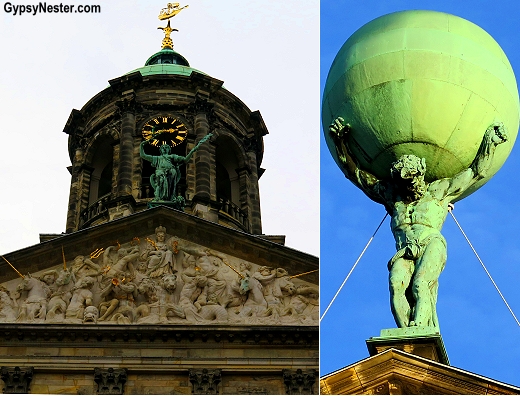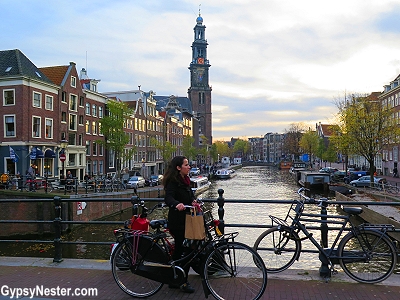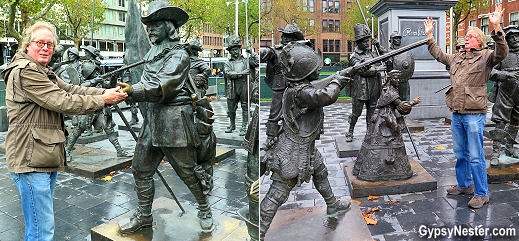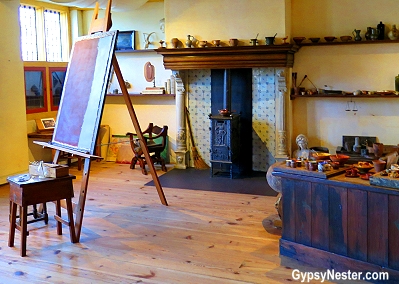

Amsterdam has a reputation, but the hedonistic side of this city is just a small part of what attracts so many people.
For us, that aspect was a mere curiosity; the real allure is the entirely distinctive personality of this vibrant, energetic, aqua-centric city.

Often referred to as the Venice of the North, we found some discrepancies in that description.
Yes, they are both built around a system of canals, but there are as many variances as similarities.
The most noticeable is in the cityscapes; Amsterdam’s main canals were laid out in an arc around the city center, whereas in Venice the canals seem to meander aimlessly.
We had to get out on the water to properly see the city!

We figured there’s no better way to observe this than from the water, so we hopped on a canal tour for a quick overview.
In the early 1600s three waterways, now known as the Canal Ring, were built to develop the city outward just as Holland was entering its Golden Age.

Dutch ships and merchants spanned the globe over the next century and Amsterdam grew into one of the world’s great cities.
As the city expanded, a distinct architectural style developed; space along the waterways was limited so builders chose to make narrow, deep houses two or three times as long as they are wide, standing three or four stories high.
Watch:


From the boat, we couldn’t help but notice the propensity for these older buildings to slant every which way.
The land is very soft, so wooden pilings had to be set deep enough to reach more solid ground in order to build.
But these have settled over time and left some crazy-crooked structures.

The design makes it difficult, if not impossible, to get furnishings in and out, so almost every home has a hoisting beam attached above the highest window.
This way furniture, or other heavy materials, can be pulled up and brought inside through the large upstairs windows.
Think piano movers in an old silent movie, that’s the idea.
This feature also adds to the crooked look of the houses, since they were built to lean slightly forward so that loads raised on the hoist wouldn’t bump up against the front of the house.
See more views of Amsterdam from the water on our canal tour!
We can’t believe we got to stay here!
An alternative to living in a crooked house is to reside on one of the myriad of boats lining every available inch of space along Amsterdam’s waterways.

Over the past few decades many of these former freight haulers have become fashionable residences, with a few available as vacation rentals.
We were lucky enough to secure one for our stay — one of the many benefits of off-season travel — and loved the connection to the city’s watery history this gave us.
 The famous Skinny Bridge as seen from the deck of our houseboat – learn more about Skinny Bridge and the story behind it’s name
The famous Skinny Bridge as seen from the deck of our houseboat – learn more about Skinny Bridge and the story behind it’s name
Our boat was on the Amstel River, just upstream from the original dam, Aemstelredamme, which gave the city gets its name back around 1170.
So did we stay out of trouble? Depends on how you define trouble!

Dam Square, home to the Royal Palace, War Memorial, and the Nieuwe Kerk, or New Church (which is new because it is only 600 years old), stands on top of the old dam.
This makes a great starting point for exploring the old town and the famed red light district.



The red light district section of the city that has contributed to its somewhat dubious reputation.
Amsterdam has had a long relationship with the world’s oldest profession, legalizing it two hundred years ago, and unofficially looking the other way for a long time before that.
In this section of town, known as De Wallen because of the old city walls, things became particularly out in the open, likely due to the proximity to the port.
Sailors will be sailors, after all.

Oddly, this is also the site of the Oude Kerk, or Old Church, which is not only the oldest church, but the oldest building in town.
Originally the church was dedicated to St. Nicolas, the patron saint of sailors, so perhaps that explains the proximity of the prostitution… shore leave and all.

No matter how it happened, it was strange to see sex workers in windows right across from a church.
Another quirk that struck us as odd was that the entire floor is covered with graves.
The church was built over a cemetery, and the practice of burying people continued inside the building.
Twenty-five-hundred graves, containing around ten thousand souls, were put here before the practice stopped in 1865... follow us into the Oude Kerk to see more about this quirky church!

The area has more recently become home to many of Amsterdam’s “coffee shops” that sell marijuana and other cannabis products.
The trend began in the seventies, when these sprung up operating outside the law.
For a while the authorities tolerated them, as long as things didn’t get out of hand. Now they have become registered businesses and are taxed and regulated as such.


We didn’t participate in any of the offerings from either group of these entrepreneurs, but looking is allowed, and we must admit to our curiosity (not that we’re judging, we’re just more comfortable with a cold beverage and each other’s company). 😉
Sure, Amsterdam has a reputation, but more than anything this stems from a long tradition of tolerance, and an open-minded, live-and-let-live attitude.

Since the activities involved happen everywhere in the world — whether legal or outlawed — the city has chosen to address the situation by keeping things out in the open.
Seems odd to us, but who are we to say it’s not a reasonable solution?
Visiting Anne Frank
Not far away, but light years removed in significance, we visited the Anne Frank House.
This is the actual building where the Frank family, along with their friends the Van Pels and Fritz Pfeffer, stayed hidden from the Nazis for two years.
The house consisted of several upstairs rooms that were sealed off from the work space and offices of the business that Otto Frank owned.
Anne called it the Secret Annex in her famous diary.
As we walked up the tiny, hidden stairway and through the rooms, the story unfolded in quotes from Anne’s diary.
The rooms have been left without any furnishings just the way the Nazis left them after capturing the family and, to us, the intensity of the small space was actually accented by the emptiness.
We appreciated that there was not a recreation of the interior, our imaginations easily filled in the space.

Anne’s father Otto, the only one of the eight to survive the war, insisted that the house be left in this way, understanding the power of the stark portrayal.
He was instrumental in preserving the house, and also in getting his daughter’s diary published.

Anne Frank’s story is heartbreaking, and made even more poignant by two facts; the allied forces were only a matter of weeks away from liberating all of Europe when she passed away, and she expressed the desire to be a famous author, which she accomplished only after her death.
Read more about the Anne Frank House and how it made Veronica feel to visit
Make sure the you have time to take this must-do, emotional tour when visiting Amsterdam – the line to enter can be hours long. An option is to get advance tickets, but there is often a waiting list, so plan ahead. The link for tickets is here
Talkin’ Tulips

On a much lighter note, the Amsterdam Tulip Museum is right across the Prinsengracht, or Prince’s canal, the outermost of the famous Canal Ring.
 We walked over the bridge and into a colorful collection of all kinds of blooming bulbs.
We walked over the bridge and into a colorful collection of all kinds of blooming bulbs.
Inside we quickly discovered that there is quite a flowery history to the tulip and its relationship with Holland.
 Brought from Turkey by biologist Carolus Clusius over four hundred years ago, tulips caused such a craze that the first ever speculative commodity bubble was inflated as people began trading the bulbs with reckless abandon.
Brought from Turkey by biologist Carolus Clusius over four hundred years ago, tulips caused such a craze that the first ever speculative commodity bubble was inflated as people began trading the bulbs with reckless abandon.

Before long, a single bulb was worth well over the annual salary of a reasonably wealthy merchant.
At the peak, ounce for ounce, tulips were selling for about one-hundred times the price of gold.
But the inevitable crash came and economists learned about market bubbles – but apparently not how to prevent them from reoccurring.
Dutch Masters

Perhaps it would have been better to invest in art, since Amsterdam is also home to some of the world’s greatest masterpieces.
Several are in the Rembrandt House Museum, which just happened to be a few blocks from our houseboat.
The artist lived there from 1639 until 1656, when bankruptcy forced him out.

 To settle his debts, all of his belongings went on the auction block, but his misfortune made for a better museum because the auction list aided in reconstructing the house just as it had been.
To settle his debts, all of his belongings went on the auction block, but his misfortune made for a better museum because the auction list aided in reconstructing the house just as it had been.
His office, living quarters, and studio all have been recreated in fine detail, including the collection of relics and oddities that contributed to his financial difficulties.

The insolvency didn’t seem to harm his work though, and Rembrandt, along with his contemporaries of the late seventeenth century, became known as the Dutch Masters.
We have no idea how the term came to be applied to rolled tobacco products.

Two centuries later another Dutch painter also became famous, Vincent van Gogh. His works are on display at several venues around the city, but the largest collection, in fact the largest in the world, is housed at the Van Gogh Museum.
The collection is displayed along with works by some of his contemporaries, such as Monet and Picasso, in a sort of timeline that we followed as we went up through the four floors.

The museum dedicated to van Gogh is a short tram ride away from the old town in Museum Square, and both the tram and museum were covered by our Iamsterdam city cards.
In fact, the cards also included our boat tour, and almost all of the other attractions we visited.
Dutch treats!

No GypsyNester adventure is complete without digging into the local food fare and our first encounter was with bitterballen.
These little deep-fried balls of meat, broth, flour, and butter, rolled in a crunchy breadcrumb coating can be found in just about every bar and cafe.

But bitterballen are just a snack, for real stick-to your-ribs comfort food we indulged in a stamppot — or hutspot to be exact — the most traditional of the stamppots.
The hefty mix of mashed potatoes, carrots, onion, and rookworst, a Dutch smoked sausage, dates back hundreds of years.

This staple became especially popular during World War II because the vegetable ingredients could be locally grown, underground.
It’s not fancy, but it certainly fills the tummy.
Our go-to dessert had to be the little puffy pancakes drizzled with chocolate sauce and powdered sugar called poffertjes.

Freakin’ delicious – even after a partaking in a stampot we could always find room for poffertjes.
We probably couldn’t handle more than one olliebollen – the heftier kissin’ cousin of the poffertjes.
We’d been on the lookout for a real Dutch olliebollen after our humbling experience with one at the Tulip Festival in Holland, Michigan (they were called “fat balls” there – an acceptable translation, but a little harsh!).

Luckily, our visit coincided with the holiday season — the most bollen time of the year — and it didn’t take long to find a festive street stall doling out the balls.
We expected a better bollen in the land of their birth, and we were not disappointed.
Translation aside (maybe oil ball? Grease ball? Yeah, there’s no way to make it sound good!), we found them lighter, tastier (and ultimately more easily digestible) than their Michigan counterparts.
Soooooo many bikes!

One last, huge difference between Amsterdam and Venice is the presence of roads… and bicycles, nearly a million of them.
The Dutch city is bustling with a crazy amount of bikes scurrying every which way, at least one for every resident.
As unnerving as this struck us at first, we quickly adapted to looking out for the cyclists, and just imagine what the traffic would be like if all of them were driving cars!

David & Veronica, GypsyNester.com
Delve Deeper:
See where we stayed in Amsterdam – hint – it’s a houseboat!
Find out how it feels to visit Anne Frank House
Experience the must-do cruise of Amsterdam’s canals
Follow us into the oldest building in Amsterdam – Oude Kerk (Old Church)
HUGE thanks to I Amsterdam and Amsterdam Book Now! for supporting this adventure – and to Eurail for the 15-day rail pass that inspired us to undertake it! As always, all opinions are our own.! As always, all opinions are our own.








Great write-up, I am regular visitor of one¦s website, maintain up the excellent operate, and It’s going to be a regular visitor.
I have not been there yet, but have been to concentration camps and other holocaust related venues. It is beyond comprehension and I won an award for a thesis on it in grad school. Just….unbelievable
I had the same thoughts as you had standing in the queue. I tried to imagine German soldiers walking up and down the canal. I imagined the bell telling her the time. I wonder what she would say if she knew how many thousands of people have now walked through that house.
My daughter, who was studying abroad in Scotland at the time, and I visited Amsterdam and The Anne Frank House a few years ago. I, too, had the same emotions as you about the book and the house. My daughter had never read the book so it wasn’t at the top of her list but she went with me as it was very important for me to see – #1 on my list also. Quite a moving place and I’m so glad I was able to go see it!
We’re’ history buffs and when we visited the Holocaust Museum in Washington, D.C. a few years ago we were filled with horror and sadness as well as a hope that humans would LEARN from this inhumanity. I, too, read Anne’s diary years before it was assigned in school and I think the reason that it hits so hard is that it puts HER FACE filled with hope on the 6 million dead…
PS – It took me a minute…but very clever title of the post!
Thanks!
Just last fall we visited Amsterdam and because of some preconceived ideas about the Red Light District and Coffee Shops I expected a seedy urban city. It is nothing like this! I absolutely loved it and I have only written about our food tour by bike, but you have inspired me to share more of our trip. What struck me the hardest at the Anne Frank house was that they stayed in those tiny rooms, in the dark, for two years and it was all for nothing. (Except of course for her father) I was so in awe of their bravery.
We were too Suzanne.
I read Anne’s diary as a young teen or tween and I extensively studied World War II through college. However, once I had my own children, I couldn’t bear to read anymore. They showed the film “Schindler’s List” in our sons’ Sunday school. A parent was supposed to accompany them to the viewing. I had to send my sister to substitute for me.
That sounds like a very interesting place to visit. Sometimes such places touch very deeply; we visited last weekend the “Museo de la Memoria y los Derechos Humanos” here in Santiago de Chile, erected in memory of the victims of the military junta in Chile – and left chilled to the bones.
I saw the play of Anne Frank’s Diary when I was the same age she was. It felt so real and unbelievable at the time. A few years ago we found ourselves in Amsterdam and like you, I had to go and see it for myself. When we stood in the room where they lived in hiding, thinking about what they went through. I was flooded with emotion. It was an overwhelming experience for me but one I don’t regret in the least.
The Anne Frank museum is on my bucket list!
Good choice for anyone’s list.
What a beautiful blog…Anne’s life was tragic, and yet so many people have been positively influenced by her short, tortured existence on this earth. I’ve been to a concentration camp, and I left without any hope at all. I need to go to Amsterdam, and visit Anne Frank’s Secret Annex.
She was such a wonderful writer, and I found myself wondering what we’ve lost by her senseless death. I’m not sure I could handle going to a concentration camp – we visited the Zeppelin Grounds in Nuremberg just a week before we arrived in Amsterdam and I haven’t been able to work up the gumption to write about that yet – the two visits were too close together. It’s tough, but important — to understand our history.
I was mesmerized by the Diary of Anne Frank when I read it as a child. I can’t imagine what it would feel like (although you’ve given me a hint) to go through the passageway beyond the bookcase.
It’s a very moving experience Donna. I hope you have a chance to see it for yourself.
I wanted to visit the house when I was there. But I was too coward. 🙁 Now I regret it.
I was worried about that too Fabiana, and I’m not going to lie, it was really, really hard to take. BUT, it is done with such respect and the knowledge of the importance of Anne’s message… the House created a memory I never want to forget. Next time you have a chance, do go.
What a beautiful and poignant post~
I recently finished reading Sarah Wildman’s book about the holocaust, Paper Love. You might enjoy it.
Thanks Irene, and thanks for the book tip too.
Reading this post was very emotional- I can only imagine what it would feel like going there. The pain those walls hold! I remember reading the diary when I was a young girl. I grew up with a mother named Anne Frank- it was strange discovering there was another one reading about her life.
I’ll bet that was an interesting experience connecting the same names. The visit was very emotional for us too.
Wow, how powerful, I haven’t taken that tour and I can imagine just how impactful that must be to be present and really she things from her experiences.
You really should go Noel, it is so well done. Anne Frank has things to teach us all.
Yes, visiting the Anne Frank House is a must in Amsterdam and a very powerful experience. I will never forget it.
You are so right Carole, should not be missed.
What a touching post – it brings back memories of reading the Diary of Anne Frank as a child myself. It was a heartbreaking story in so many ways. I’m not sure I would be able to tour her home without crying ..thanks for sharing your experience.
Tears were definitely a common experience for many visitors.
Ohh the correct translation for is Oil ball. The ones with raisins are my favourite.
Thanks Kieren, and while they are delicious, that still doesn’t sound so good. 😉
Great that you went to the Rembrandt’s House. It is one of my favourite museums in Amsterdam. There is something about standing in the space where the great master lived. Much in a similar way to standing in the annex of the Anne Frank House. Great Post thanks for showing off what our city has to off.
It was fascinating… a real look into his life. We loved that it not only focused on his art, but what interested him as a person. A new perspective, for sure!
I visited when I was very young, around 20. I would love to go back now and do it again. I think the story and her house would have a lot more impact on me now.
I was thinking about that when I was there, only backward. I wonder how I would have felt going through the Secret Annex when I was younger. -Veronica
I think I want that main course.
Good for when it’s cold outside.
I never knew until recently that Otto Frank tried desperately to emigrate his family in the months leading up to their going into hiding. I have long wanted to visit this site. Thanks for sharing your experience.
So glad we got to see it, hope you can make it there sometime too.